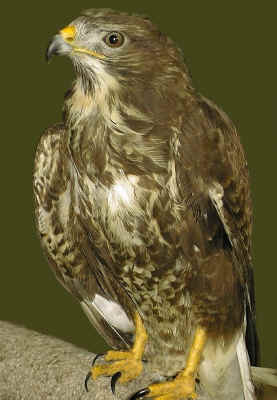Buzzard
Buteo buteo
 Majestically soaring on the thermals above the Westcountry landscape, buzzards
are now a common sight. They have a wingspan of 115-130cm and are the largest of the birds
of prey commonly seen in the south west of England. Their varied diet consists of small
mammals such a rabbits and invertebrates like earth worms. They also eat carrion.
Majestically soaring on the thermals above the Westcountry landscape, buzzards
are now a common sight. They have a wingspan of 115-130cm and are the largest of the birds
of prey commonly seen in the south west of England. Their varied diet consists of small
mammals such a rabbits and invertebrates like earth worms. They also eat carrion.
Buzzards pair in the spring. At this time 6 or more may be seen circling
in the same area. Part of the courtship may include strong and deliberate wing beats from
the male as well as the exchange of nest material in mid flight. Often repeated swooping
flight can be seen especially near the desired nest site. They nest in mature trees and
build large bulky nests from sticks. Grass and other materials such as wool are also used.
They will also takeover abandoned crows nests. Two or three chicks are usually reared.
When they are not soaring aloft buzzards are commonly seen sitting motionless on a
telegraph pole or bare branch. Particularly during the nesting season magpies, crows and
rooks will mob buzzards that stray too near their nests. During these encounters buzzards
often lower their talons to strike, whilst at the same time twisting and turning in the
air. This display seldom deters their tormentors who will stay just out of reach mobbing
the unfortunate individual.
Size: 50-55cm Female larger. Call: Mewing. Colour:
Brown with lighter flecks in the plumage but can be very variable, particularly on the
underside which from a distance can look almost cream/white.
 Majestically soaring on the thermals above the Westcountry landscape, buzzards
are now a common sight. They have a wingspan of 115-130cm and are the largest of the birds
of prey commonly seen in the south west of England. Their varied diet consists of small
mammals such a rabbits and invertebrates like earth worms. They also eat carrion.
Majestically soaring on the thermals above the Westcountry landscape, buzzards
are now a common sight. They have a wingspan of 115-130cm and are the largest of the birds
of prey commonly seen in the south west of England. Their varied diet consists of small
mammals such a rabbits and invertebrates like earth worms. They also eat carrion.